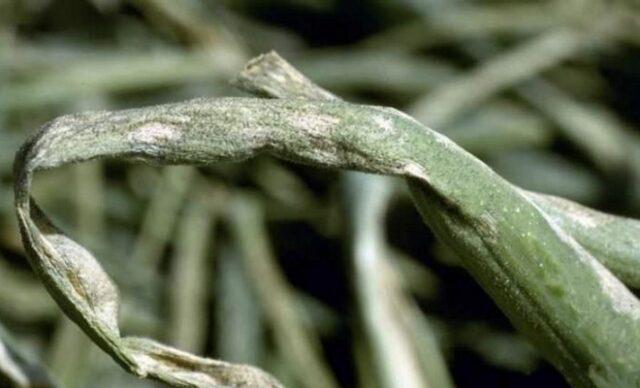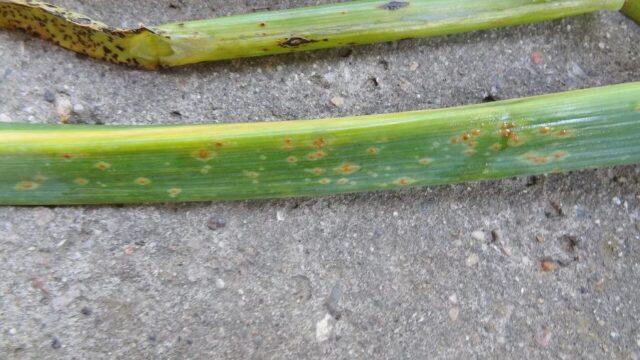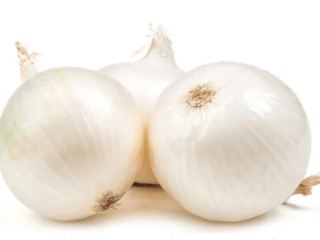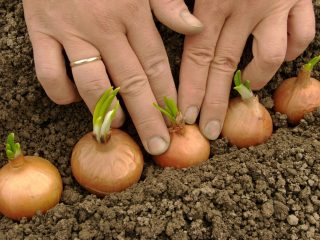Content
Chives is a herbaceous perennial with valuable nutritional and medicinal properties. It is not difficult to grow a culture in the garden, subject to the basic rules of planting and further care.
What is chive bow
Shnitt-onion, speed or chisel, is a herbaceous plant of the Onion family, known in culture since the 16th century. It has a pleasant, bright or slightly pungent taste; it is used for food at a young age of up to three weeks.
The culture is popular with gardeners due to its increased endurance and frost resistance. The leaves of the plant have not only nutritional, but also decorative properties. Chives are often planted in the garden as a honey plant or as part of artistic compositions.
What a chive bow looks like
Schnitt-onion is a medium-sized perennial with oblong or ovoid-conical bulbs up to 25 mm in length in brownish papery shells. It has a cylindrical dense stem up to 60 cm high. The shoot is “dressed” by leaf sheaths by a third or to the middle, the plates themselves are green with a waxy bloom, fistulous, up to 6 mm in diameter.
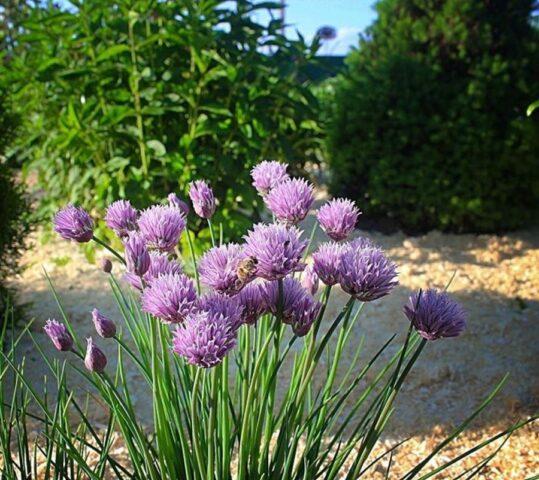
One adult speed bush is capable of producing up to eight shoots at a time
From May to August, chives bloom with pale pink or pink-purple spherical buds. In the period of decorativeness, the plant usually enters the second year after planting. Since June, it bears fruit - boxes with seeds.
Characteristics of chives
Chives have very high endurance and can easily withstand temperatures as low as -35 ° C. It can be grown in open ground not only in the middle lane, but also in Siberia, the Far East and even in the Far North.
The yield of a plant depends on the specific variety and growing conditions. But on average, chives are capable of producing up to 7 kg of leaves from 1 m2 and up to 600 g of edible plates from one adult bush. During the season, the crop can be harvested several times - the plant quickly recovers after cutting.
Unlike many garden crops, chives do not need to be transplanted annually. It is allowed to grow it in one place for 3-4 years, and if it performs only decorative functions on the site, up to nine years. The culture shows high resistance to pests and fungi and even helps to protect neighboring plantings from diseases.
Chives varieties
Chives are represented by a large number of varieties with valuable decorative and nutritional properties. Several of them are in special demand.
Bohemia
A productive variety allows you to remove up to 200 g of greens from a bush at a time. The plant rarely suffers from diseases, successfully develops in one place for several years. The first cut can be done three weeks after the leaves have formed.
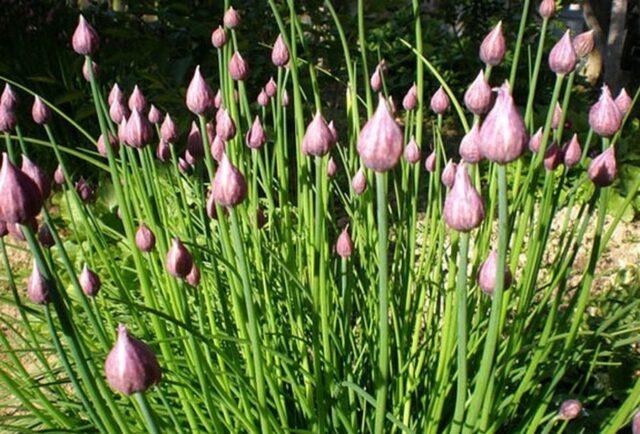
Bohemia chives have a tangy taste, but rather mild
Honey plant
Resistant to cold snaps and poor soils, the honey chives variety brings dark green leaves with a pleasant pungent taste throughout the summer.Differs in beautiful flowering, often found in artistic compositions in the landscape. In accordance with the name, the plant is a good honey plant and attracts bees to the site.

Feathers of chives honey plants grow very quickly - up to 20 cm per week
Spring
An early cultivar of chives allows the leaves to be removed just three weeks after germination. The plant demonstrates high frost resistance, in spring it is one of the first to sprout in the garden. It forms tall and rather powerful bushes, the yield is approximately 6 kg per meter of planting during the season, subject to agricultural technology.
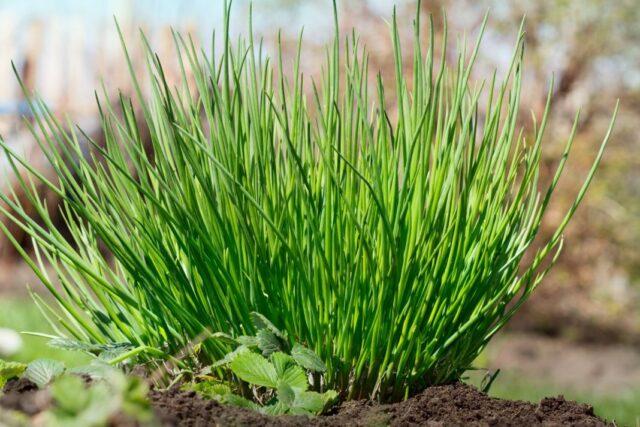
Spring chives-onion variety has a mild, slightly pungent taste.
Chemal
A low variety of chives stretches only up to 40 cm. The taste of the leaves is sharp and bright, the yield indicators are high - about 7 kg of juicy feathers can be harvested in a few cuts.
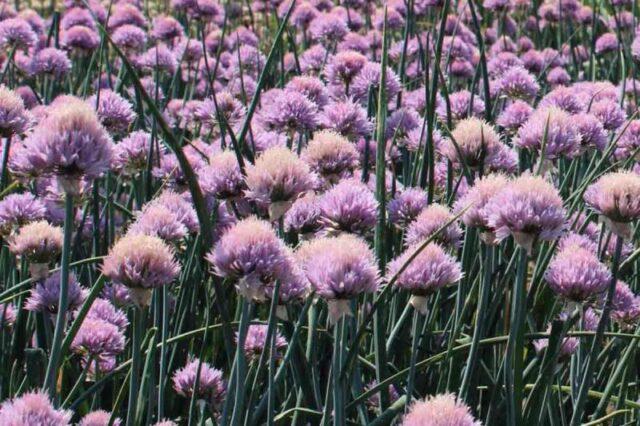
The disadvantages of the Chemal variety include weak resistance to powdery mildew
Crocus
The early ripening chives are suitable for cutting as early as 14 days after the leaves have grown. It has a pleasant taste and withstands spring frosts well outdoors. At the same time, the yield of the variety is average - about 600 g of feathers can be harvested from a meter of planting.

Crocus chives require regular transplanting, otherwise the yield of the plant will decrease
The benefits and harms of chives
The edible plant chives have numerous medicinal properties:
- improves appetite and speeds up digestive processes;
- strengthens the immune system and promotes recovery from colds;
- reduces the risk of developing atherosclerosis;
- prevents the occurrence of vitamin deficiency;
- has antimicrobial and anti-inflammatory effect;
- helps to remove toxins, toxins and parasites from the body;
- improves visual acuity;
- reduces bleeding gums;
- dilates blood vessels and regulates blood pressure;
- has a beneficial effect on the state of the genitourinary system in men and women;
- improves intestinal motility with sluggish digestion.
Along with the valuable properties, chives have contraindications. It is not recommended to consume the plant:
- with ulcerative lesions of the stomach and intestines;
- with exacerbation of pancreatitis;
- with chronic diseases of the heart and blood vessels;
- with hepatitis and cirrhosis of the liver;
- with individual intolerance;
- with frequent migraines.
Chives have a negative effect on the body mainly when consumed in excess. In excessive quantities, sharp feathers cause heartburn and nausea, diarrhea, headache, and allergic rashes.
How to plant a chives
It is quite easy to grow chives - the culture belongs to the unpretentious category. The plant can be sown directly into open ground or in closed containers at home.
Growing chives from seeds in the open field
You can sow chives on the site in the spring at the beginning of the growing season or in the fall shortly before the cold weather. A site for a plant is chosen moderately lit, with a light shade. The soil is required for cultivation loose, enriched with lime, with good drainage.
A few months before planting, the selected area is dug up and cleaned of weeds. Add a bucket of humus or 500 ml of compost per 1 m to the soil2, a small amount of urea and superphosphate is poured, after which the substrate is stirred. A few days before the actual planting of the culture, 20 g of ammonium nitrate per 1 m is also applied to the site2 and water the earth abundantly.
The procedure for sowing chives in an open garden looks like this:
- Plant seeds are soaked for a day in warm water, periodically changing the liquid, and then dried on a paper towel.
- On the site, small holes are prepared up to 2 cm deep, leaving a distance of 5 cm between them.
- The processed seeds are laid in holes and covered with soil on top.
- The beds are abundantly sprayed with a spray bottle.
In the first season, it is not recommended to cut off young leaves - the plant is given the opportunity to get stronger as it should.If this rule is followed in the second year, the bushes will bring a bountiful harvest.
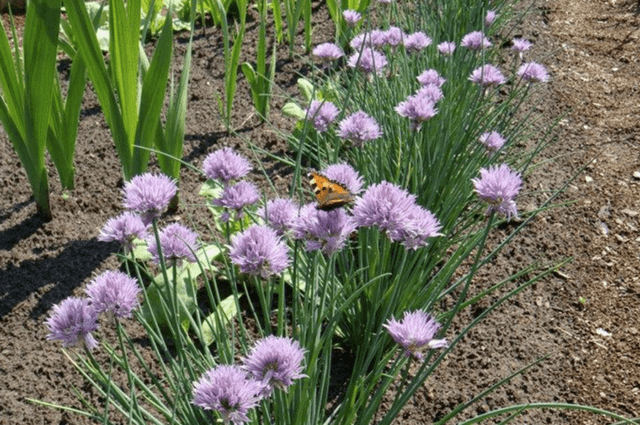
It is recommended to leave 15-30 cm of space between the rows of chives
Growing chives seedlings
You can plant chives seeds first for seedlings at home for subsequent transfer to open ground. The technology looks like this:
- A wide box about 20 cm deep is filled with a substrate of humus, garden soil, sand and wood ash, not reaching 3-4 cm to the edge. The soil is leveled and watered abundantly.
- Pre-soaked plant seeds are placed in holes 1.5 cm deep at intervals of 2.5 cm. The material is covered with soil and sprayed from a spray bottle on top, and then the box is covered with film or glass.
- For several days, the seedlings are kept in a warm place with moderate lighting. After the emergence of seedlings, the shelter is removed from the box and the chives microgreens are moved to a lighter room with a temperature of about 18 ° C.
- At the time of the formation of the first true leaf, the seedlings dive.
During home cultivation, chives need to be moistened regularly. The seedlings are transferred to the ground on average two months after the formation of shoots. Plants by this time should acquire two true leaves.
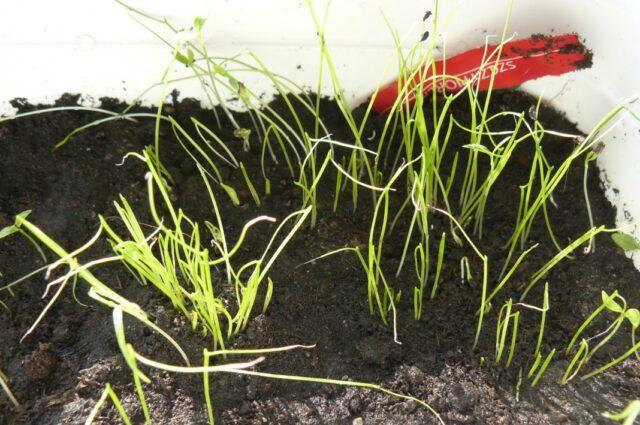
Daylight hours for chives seedlings should be at least 12 hours
Chives care
You can grow chives from seeds in any climate. Caring for a culture is not particularly difficult, but some points require attention.
Watering
Chives require abundant watering. With a lack of moisture, the plant loses its decorative effect, moreover, the leaves become too coarse and less tasty. Water the culture with lukewarm water, you need to focus on the state of the upper soil layer. Waterlogging of the soil is also dangerous for the speed, since the roots of the plant can rot.
Top dressing
Fertilizers for chives begin to be applied in the second year. Top dressing of the plant is carried out after the first cut - when watering, a solution of bird droppings or an infusion of mullein is introduced into the soil. It is also allowed to sprinkle the beds with dry minerals - nitrophos or azofos, 40-100 g per 1 m2.
When using organic matter, you can feed the plant after each collection of leaves. Mineral fertilizers are applied less often - after 2-3 cuts.
Loosening and weeding
Adult chives form a dense turf on the soil surface and usually inhibit weed growth on their own. But young plants 1-2 years old are recommended to be weeded and loosened monthly. This will additionally protect the speed from pests and fungi and improve oxygen access to the roots.
Preparing for winter
The speed plant tolerates severe frosts well. But the rules for caring for chives in the fall still recommend insulating the garden. Usually a dense layer of mulch is used - the soil is covered with dry foliage, sawdust, and covered with spruce branches. In the spring, with the onset of the thaw, the shelter is removed so that it does not interfere with the growth of culture.
Disease and pest control
Chives rarely suffer from pests and diseases, since phytoncides in the plant scare away insects and destroy pathogenic microorganisms. But some ailments still pose a danger to speed:
- Powdery mildew. Fungal disease can be recognized by pale green spots on the leaves of the plant and a whitish bloom. With an advanced ailment, the affected areas turn brown over time, and the chives plates die off.
Powdery mildew appears on chives in extremely damp conditions
- Rust. Another fungal disease leaves brown-red marks and swellings on the plant.The fungus spreads quickly and can destroy the entire garden in a short time.
Rust on a plant soon develops with an excess of nitrogen in the soil
The fight against onion diseases is carried out using the fungicides Topaz, Fitosporin and Baktofit. It is not recommended to cut the leaves of the crop for food use within a month after spraying. As a prophylaxis for fungi, it is necessary to maintain cleanliness on the site and remove plant debris in time, in which pathogenic microorganisms hibernate.
Of the pests, the danger for chives is mainly thrips. You can remove parasites using the drug Aktara or Bordeaux liquid. To prevent thrips from multiplying in beds with chives, before the onset of winter, you need to clear the area of rotting plant debris.
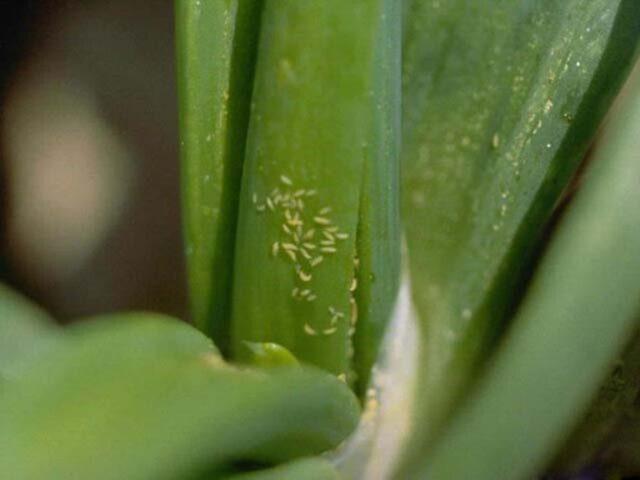
Both adult insects and thrips larvae feed on the frying pan
Reproduction
You can multiply the speed on the site by the method of division. This allows not only to increase the plant population, but also to rejuvenate old bushes that are no longer able to demonstrate high yields.
The division for chives is carried out in the spring or early fall. The procedure is performed as follows:
- On the selected day, the plant bed is watered abundantly.
- They dig in a short time with a shovel and carefully remove it from the ground.
- The leaves of the bush are cut to 15 cm, and the roots up to 5-7 cm.
- Manually or with a knife, the plant is divided into several parts with 8-10 bulbs each.
- The resulting small bushes are transferred to new places and planted in the usual way.
Caring for chives after dividing is carried out according to standard rules.
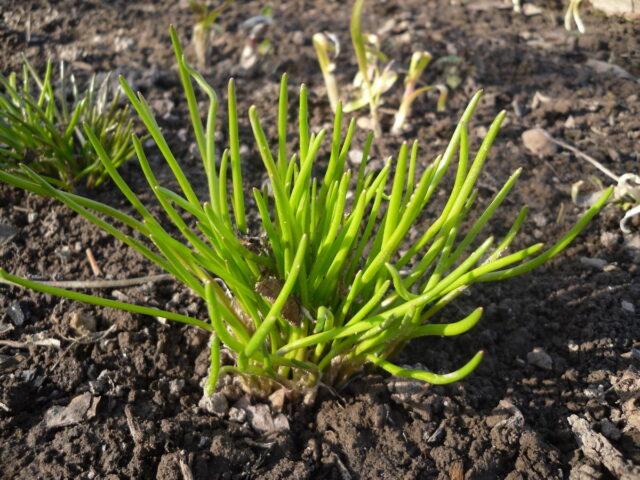
Chives are recommended to be divided at the age of 3-4 years
Harvesting and storage
For the first time, the harvest is carried out in the second season after planting. Young succulent leaves are cut off in full or only a few feathers are taken from the plant. At the same time, small stumps are left above the ground. Flowering stems are removed during the summer as soon as they emerge to prevent leaf coarsening and preserve their juiciness.
From spring to the end of summer, chives can be fully cut 2-4 times, depending on the variety and growth rate. The last time the leaves are removed in mid-August and no longer disturb the speed before the cold weather, so that the culture has time to accumulate a supply of nutrients before the onset of winter. The best taste is possessed by feathers stretching up to 25-40 cm in height.
You can keep chives fresh in the refrigerator for up to two weeks. If it is necessary to prepare the feathers of the plant for the winter, they need to be frozen at negative temperatures or dried. In both cases, the speed will retain maximum benefits and will not lose taste.
Conclusion
Chives is a beautiful and healthy plant with good yields. The culture does not make high demands on care, but it allows you to get tasty and juicy greens several times during the growing season.
